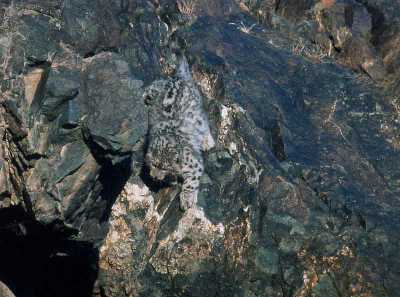| Fritz Pölking | <-back |
The Snow Leopard
A ghost in the high mountains of Asiarare, mysterious, endangered and as yet almost never photographed.
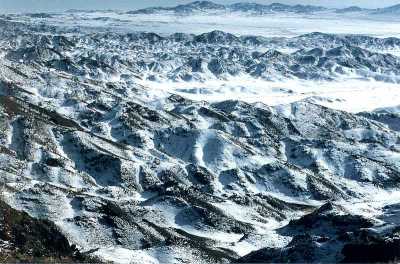 |
| Because of the dry
climate there is only little snow in the Altai mountain range even in the depths of winter and severe cold. |
In the past the big museums of the world have sent off various expeditions to explore the life of the snow leopard; which nonetheless is still the least known big cat. Discovered was the snow leopard in 1761 by North Americans and two scientists in particular distinguished themselves and performed pioneer work in exploring the life of this fascinating cat: Georg Schaller in the seventies in Pakistan and Rodney Jackson in Nepal in the eighties.
The American Peter Matthiessen once accompanied Georg Schaller on one of his snow leopard expeditions lasting for several months and even wrote a book about it. However, during the entire expedition he never caught sight of any of them. Only Schaller himself had a short encounter. As Matthiessen says in his book until then there had been only two whites who in the past 25 years had caught sight of a snow leopard in the wild. Schaller himself had during the many years of his field research seen only three snow leopards: two fully grown specimens and a young one. Mafdan Oli, another researcher from the small group of people who ever had the opportunity of observing this cat, saw the snow leopard during twelve months of full-time field studies only two times. Rodney Jackson and Darla Hillard were somehow more successful: they after all saw the ghost of the high mountains of Asia eighteen times in four years of field studies.
The story of the exploration of the snow leopards has thus not taken a particularly successful course for if you sit for about four years in a tent camp high up in rugged mountains to explore these felines and then perhaps every three months you see them for a second or so if you are lucky or perhaps even every six months, then this is not only very frustrating for the researchers but does not produce an excess of new findings either. Thus Georg Schaller was quite right to say: "As yet we still know practically nothing about the life of this cat."
Funnier still than the story of their exploration is the story of the attempts to photographically document their life in their natural surroundings..
Georg Schaller succeeded in 1970 in taking the first known out-door photograph of a snow leopard in the Hindu Kush Mountains of Pakistan. During their research works in the Himalayas in the eighthies Rodney Jackson and Darla Hillard put up a photo trap and in 561 nights, that is in almost two years, they merely got four usable pictures where the cat had photographed itself. But that is already all of the pictures of the mysterious snow leopard having so far become known.
All other photos one sees from time to time have either been taken in zoological gardens or at game farms or were taken of animals caught by scientists in snares and thus hardly able to run away or having been stunned with the stunning rifle in order to put a transmitter-equipped collar around their neck so that later on after having released them they can trace their movements in freedom by following the radio signals.
There are perhaps still some voucher photos having been taken by scientists but after all having become known so far only one real picture of the snow leopard existed until 1996: the one Georg Schaller took in 1970.
Occurrrence
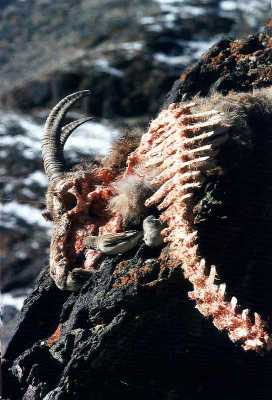 |
| A snow leopard's the
remainders of a female ibex. The leopard has carefully devoured its prey not leaving anything of it. Only the little songbirds still find some pieces of flesh on the skeleton. |
Nobody can answer the question as to how many snow leopards there are living in freedom. Researchers have calculated that there may be 7,000 at the most, perhaps even only 4,000. The Mongolian People's Republic reports for its territory a stock of 1,700 specimens. Others are found in India, Pakistan, Afghanistan, Nepal, Bhutan, Tibet, China and the Central Asian republics of the former USSR. There they live at heights ranging from 3000 to 6000 m and preferably in mountainous regions situated far away from roads and villages. The mountainous regions with rugged steep faces, a not very sumptuous supply of food and the severe winters with a great deal of snow and crisp cold do not make life very easy for this cat, yet on the other hand this not very humane environment offers it the chance to survive. Mt. Everest,. the highest mountain of the world, is also the home of the snow leopard.
Its homerange is sized 12 to 40 sq.km, yet may also be 100 sq.km depending upon the availability of food. It lives mainly on wild perissodactyls such as blue sheep, ibexes, markhors and the argali. In the summer it likes to capture Himalayan marmots and in the winter it goes after the livestock of the mountain farmers. But most certainly it won't refuse - like any other leopard - birds and small animals either.
There is no other cat living at heights the snow leopard lives at although it follows its quarry down to lower areas, that is down to about 1800 - 2000 m.
It prefers rocky terrain where it can make out and observe its prey from cliffs and rock peaks. It is superbly adapted to the life in the rocks in high altitudes through its thick coat and its colouring rendering it invisible already from a short distance.
Description of the Animal
There is still no complete consensus among the scientists as to whether the snow leopard belongs to the big cats, that's why-it earlier on had (and partly still has today) the generic name of "Uncia" (ounce) whereas since some time it is more and more being classified under the genus of "Panthera", that is together with lion, leopard and tiger.
Its scientific name is today predominantly given as Panthera uncia, thus the genus big cats, although the snow leopard like a small cat devours its prey sitting and not lying down like all the other big cats.
The snow leopard has many names (Irbis (Russia, Mongolia), Sah (Tibet), Shan (Laddak) Barfani chita (IJrdu) and Heung chitawa (Nepal). It has a body length of 1,2 - 1.5 m or 2 m including its tail. In freedom it can weigh 40-60 kg (sometimes up to 75 kg) with a shoulder height of 60 - 78 cm.
The colour of its coat varies from white to creme to yellowish or grey and its thick fur protects it against both cold and sun. Its paws with a thick sole cushion prevent it from sinking too deep into the snow. 16 m was the largest distance measured so far for a wide jump made by a snow leopard and as a result thereof it should be the holder of the world record in this event among all creatures living on this planet.
Behaviour and Prey
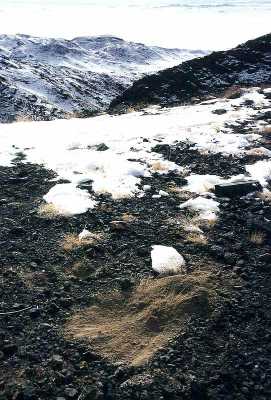 |
| Cat toilet. Where there are
snow leopards around one finds them often in the winter. They are possibly also a part of the social marking system of scent marks and scratch marks. |
Its secretive way of life and above all the jagged mountainous landscapes not very suitable for observations by man which it inhabits as its habitat render observations extremely difficult. It is active at twilight and a loner; only during the mating season and when the females introduce their cubs to the life they are not alone.
The mating takes place towards the end of the winter or in early spring and the two to three cubs are born 90-100 days later. It is said that the young stay with the mother for more than one year, probably even 16-18 months. When they fail to capture prey they feel inclined to go to another area every day. With a big quarry they are sometimes occupied for up to a week and in such case they, of course, stay in its vicinity all the time.
The so-called cat toilets do surely belong likewise to the social marking system of scent marks and scratch marks which perhaps allow the recognition of different individuals. This conclusion is supported by the fact that such marks can be found particularly often during the mating season from January to March.
Protection
87 % of the local population in its home region of South-East Asia are in favour of a radical extirpation of the snow leopard. The newspaper 'The Mongol Messenger' reported on 9.6.1995 on page 3 that the Mongolian customs authorities confiscated 200 furs in 1994 alone with a total number of 1,700 specimens in the whole of the country. For a fur the villagers from Bhote got about 10 US dollars. For a fur coat one needs 16 furs. It sells for 60,000 US dollars.
The only - perhaps - effective protection would be the establishment of a national park for snow leopards equipped with really adequate financial funds from Europe and North America. For we are the only ones who really want to protect it; all the others more or less don't mind either way whether it is extirpated - if they don't even welcome it.
Diary of an Encounter
July 1995:
High up in the mountains of the Trans Altai Gobi National Park in Southern Mongolia I had put up my tent next to the yurta of a herdsman's family.
Up here I wanted to look for the legendary and mysterious snow leopard which until now hardly had really been photographed in its natural surroundings. Only a couple of amateur snapshots existed taken by scientists which, however, could only be regarded more or less as voucher or remembrance photos.
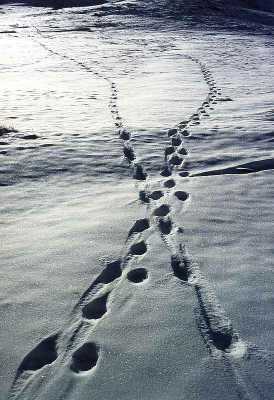 |
| A rare document: three
tracks of snow leopards are crossing each other. Two of the animals moving uphill and one track of a specimen coming down. |
After a few days I realized that I was at the wrong place at the wrong time. There wasn't as much as a hint of a snow leopard to see or to even suspect. Firstly the mountains were much too steep and too high in order to be able to systematically search for them, secondly the elegant white cats fed now in the summer preferably on marmots which unfortunately live in the highest caves of the mountain range and thirdly it is impossible without any tracks in the snow to determine whether there were any at all - and how many and where. Scientists have it a lot easier in such case: they only need to catch the cats and put a transmitter equipped collar on them.
One chance I saw only later on in the year-when in September the marmots had retired to their holes and the snow leopard therefore also visited lower areas of the mountain range to look for food. Therefore already after one week I broke off my attempt to observe and photograph snow leopards.
January 1996:
In the Djunga Gobi National Park this month a snow leopard had captured a horse foal: The livestock breeder was not amused. Horses are a very valuable property and practically part of the family. - One day later the snow leopard was dead.. (according to rumor).
In wintertime the food conditions are more critical for the big cats because the marmots are missing. Last week a snow leopard mother came down into the valley on two successive nights accompanied by three young ones aged about 10 months and each time killed a yak belonging to one of the herdsman.. .
Around this time of the year it is difficult for a leopard mother to capture enough food for herself and for three big young. In such time the hunger is big - and the tame pasturing cattle of the Mongols an easy and tempting prey... Some days later all four leopards were dead (Says the rumor).
In a relatively small area of perhaps 50 sq.km in which I now stayed gathering information thus five snow leopards had been perhaps killed within only one month. I wonder how many snow leopards will be killed in the twelve months of a year in the whole of the Mongolian People's Republic - and in China, Russia, Nepal etc.
although it is theoretically protected everywhere all year long?
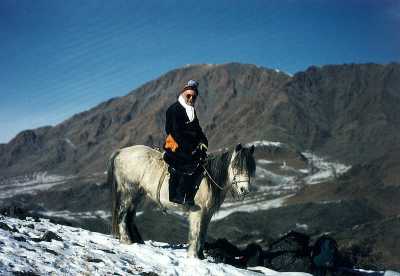 |
| The author on his way to
work - the search for snow leopards in the Mongolian Altai mountain range. |
A small taste of what happens gives you perhaps the news item which the daily newspaper Ulaanbaatar News published in October 1995 according to which 200 furs had been confiscated at the local airport in the course of the past year. If taking as a basis the figure usually quoted by the police, i.e. that only about 5 % of all smuggling cases are discovered, then this adds up to a huge number of snow leopards being killed every year.
The family I lived with here in the Altai Mountains had about 100 sheep, 100 goats, 20-30 head of cattle and yaks, 5 camels and 20 horses. In the last year the big animals together (horses, cattle and yaks) had had 7 young - none of which survived. Two died from cold or diseases and five were killed by wolves and leopards.
A tragedy for the family: the animal harvest of a whole year had practically been destroyed.
It is rather easy and very comfortable in Europe and America to demand the strict protection of all snow leopards because to us that doesn't mean any sacrifice at all. To expect others to accept without complaint heavy losses for the benefit of nature protection is easy and cheap.
A fine example of the lip service of the Europeans I experienced last automn in Germany in the Bavarian Forest. There the government of the Free State of Bavaria intended to slightly enlarge the national park having been in existence for 25 years, that is to say by wooded areas owned by the State anyway. Thus nobody would have had to make a sacrifice. Depite all that a storm of indignation broke out among the local population; the municipality of Freyung and others organized protest meetings at which the supporters were swept away. And just because the natives would no longer be allowed to go straight through the wood once the state forest had been converted into a national park, but would have to stay on signposted trails..
That's how we humans are: Others are to accept without complaint the destruction of their entire year's harvest, but oneself is not even prepared to stay on paths..
If we really wanted to protect the snow leopard we must compensate the people living there for the loss of their animals, at least financially. That is quite simple: Animals killed by snow leopards are recognized by the killing bite in the neck or throat and by the fact that the snow leopard devours its prey always starting with the 'butt'. If the Western nature protection organisations and governments really and seriously want to protect and preserve this beautiful cat then they should make available a sufficient amount of funds so that the people can be compensated. All other declarations of intent are nothing but printed paper...
February 1966:
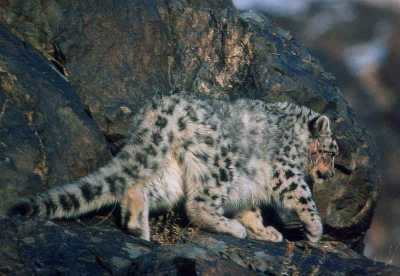 |
| Slowly the snow leopard moves away. In
this picture one can clearly see that its tail is considerably bushier than that of the leopards in Africa |
Early this month we systematically searched the ridge of a mountain over a distance of about 3 km for tracks and in the process found four preys of the snow leopard: a female ibex, a horse foal and two yak calves - furthermore a wild animal and three head of pasturing cattle!
One yak calf was already completely devoured and to judge by the tracks the cat had visited it in three successive nights. As to the other yak calf the haunches had just been nibbled at and it showed 'beautifully - like from a textbook' the killing bite of the leopard at its victim's throat. The nine month old horse foal had already been dead for about two weeks and also at the ibex a leopard had been feeding for two to three nights in a row as we were told by the tracks. Last night it had probably been here for the last time for there was nothing much left.
This mountain ridge seemed to be a good spot to see the night-active irvis at least once because we found as much as '20 cat toilets' and a number of tracks leading to and from the mountains showed us that this was no bad area for someone who by all means wanted to see and photograph one of these mysterious cats despite the snow and 30 degrees centigrade below zero at a height of 2,000 to 4,000 m.
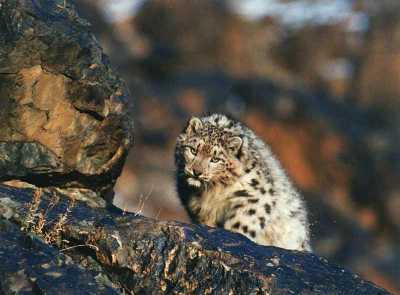 |
| The snow leopard coming over the
mountain ridge and moving towards the camera. The nature photographer does not seem to interest it. |
One afternoon in February at about 16.30 hrs - in a wondergul evening sun - the moment had finally come: we slowly rode along a mountain ridge always looking out for tracks and traces of the big cat when we saw 'two' snow leopards: one was about to disappear over a rocky ridge approximately three meters high and the other one lay down in front of it and observed us.
The two cats were about identical in size, thus it was no pair in the mating phase nor mother and child, but they must have been brothers or sisters from spring 1994, thus now just under two years old.
After some time the second snow leopard, too, sneaked away withdrawing around the rocky slope in the same direction into which the other one had disappeared as well.
I now tried with utmost care and very slowly to get on foot on the other side around the rock and climb down the 20-39 m in order to then be at about the level where the two would have to be about 30-50 m further to the left.
When finally I had a clear view a phantastic sight offered itself to me: the first snow leopard had hidden itself in a cave and the second one had paid him a visit, yet without considering my presence as being so serious that it now should likewise go into a hiding place. It first stayed a couple of minutes with its brother (or sister), then climbed a bit higher onto a ledge - and disappeared behind it. A short while later it returned and - came directly towards my camera: the nature photographer with his telelens didn't seem to have impressed it in the least.
That in alike situations one cat stays in hiding and the other one strolls around quite lightheartedly is typical of leopard behaviour which already I observed quite often in Africa. There, for instance, I followed a leopard mother with her cubs for a number of years with my camera and it was interesting to see how careless the son and how careful by comparison the leopard daughter was. The son often ran 10-20 m ahead when the family went out for a stroll whereas the daughter stayed at her mother's side. When unkown territory had to be crossed then the daughter always waited until mother and brother had gone ahead and gave her the "All clear" signal: only then she followed them.
Also this 'hiding' with the head stuck in the cave and the body left visible I already observed several times with leopards. Perhaps the animal thinks that when it doesn't see the danger the danger can't see it either. As a defensive position this posture is surely very inappropriate indeed.
I still recall rather well a situation involving an African leopard female about three years ago when one morning the same took one of her about 2-month old young carrying it in her mouth - to a new cave. Halfway on her way to the cave she was surprised by a horde of baboons attacking her right away. With her child in her mouth she didn't have much of a chance and therefore fled into a small cave this time letting her tail hang out as well. The baboons just had enough courage to approach the leopard far enough to touch her tail several times but without pulling it or biting into it. The leopard didn't move but waited motionsless until the baboons finally cleared off.
On the grounds of these experiences I would have been able - theoretically - to pull without any danger a free-living leopard's tail. What an incredible thing to imagine! Three reasons spoke against it: Firstly I am not a courageous man, secondly one is to have respect for one's fellow creatures and thirdly I was at the same level, that is true, but separated by an unsurmountable incision - only about 10 m wide, that is true, but instead about 200 m deep.
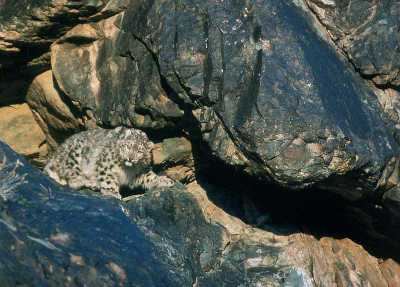 |
| Two snow leopards! While one of them only shows the
white tip of its tail in the shadow of the edge of the rock the other one moves past keeping a watchful eye on the nature photographer. |
After about a good half hour the snow leopard probably began being bored I assume and it disappeared in the maze of rocks whereas the second one still stayed motionless in the crack when - unfortunately - because of the setting-in of dusk we had to leave the mountain ridge in order to still make the steep descent in the daylight.
To climb around at a height of two to four thousand meters in the winter cold of down to minus 30 degrees centigrade is neither particularly funny nor easy. Therefore I had only taken along a small photo outfit: the Nikon F4 with the lenses 2.8/35 mm, 4.0/80-200 mm and the Nikkor 5.6/400 mm with the 1.4x converter TC14b. Furthermore some Fujichrome slide films Sensia-100, the light-weight Gitzo carbon tripod make Mountaineer and for the camera four lithium batteries. It all superbly proved its worth under the conditions prevailing here the outfit was - just about - still portable in the steep mountains, the carbon tripod in the extreme cold very pleasant (one could touch it without getting stuck on it or having a cold shock) and the batteries worked perfectly even at minus temperatures so that in the end some pictures of this encounter worth remembering- at least as far as I am concerned - with the ghosts of the high mountains of Asia turned out quite well after all.
In Zoological Gardens
There are about 300-500 snow leopards in zoological gardens, game farms and similar institutions. 230 specimens are kept in 50 American zoos (USA and Canada) and they are practically the substance of a snow leopard survival scheme in case it is extirpated in their natural surroundings. Zoobiologists believe that this number will enable them to save 90 % of the genetic program of this species over the next 200 years. Then mankind will - perhaps - have reached a point where the leopard can survive in the wild as well or we will have reached a point where we need not worry any longer about the snow leopard protection schemes because we will have quite different worries or - one way or the other - no more worries at all.
